 Approved by Dr. Dwight Alleyne, DVM
Approved by Dr. Dwight Alleyne, DVM All The Signs Of Pain In Dogs & What You Might Miss
You might think a dog in pain would whine, yelp, or bark the house down - but as it turns out, the signs they give us might be easier to miss than the "obvious" ones. Here's how to figure them out - and get your buddy the help they need.

Dogs are tough little troopers. They’re built with a remarkable ability to ensure discomfort without much complaint. Which, sadly, is actually how we end up missing the signs of pain in dogs – until their health takes a turn for the worse.
As a loving dog parent, it can be heartbreaking knowing your buddy’s suffering – and not being able to communicate it.
But here’s the thing: dogs DO give us clues, even if they’re subtle. Your mission, should you choose to accept it, is recognizing the signs your buddy’s struggling with pain or discomfort – and taking action.
So, here’s everything you need to know about the signs of pain in dogs, what behavioral changes to watch out for, how to relieve their discomfort, and the Activity Tracker that might end up saving your dog’s life. Let’s get started.

Find out how your dog spends their time.
Read moreWhy do dogs try to hide their pain?
Because it’s exactly what their wild ancestors would’ve done.1 In fact, your dog’s brain and behavioral patterns aren’t much different from what they might’ve been thousands of years ago.
- A wild wolf or wild dog showing signs of weakness or pain would be a prime target for other predators.
- It’s why your dog might not immediately demand your attention or make a nuisance of themselves right away.
- No matter how sociable they are otherwise, they might seem withdrawn, more reluctant around playtime, or even more irritable than normal.
(Kind of like us humans when we’re sick, to be fair.)
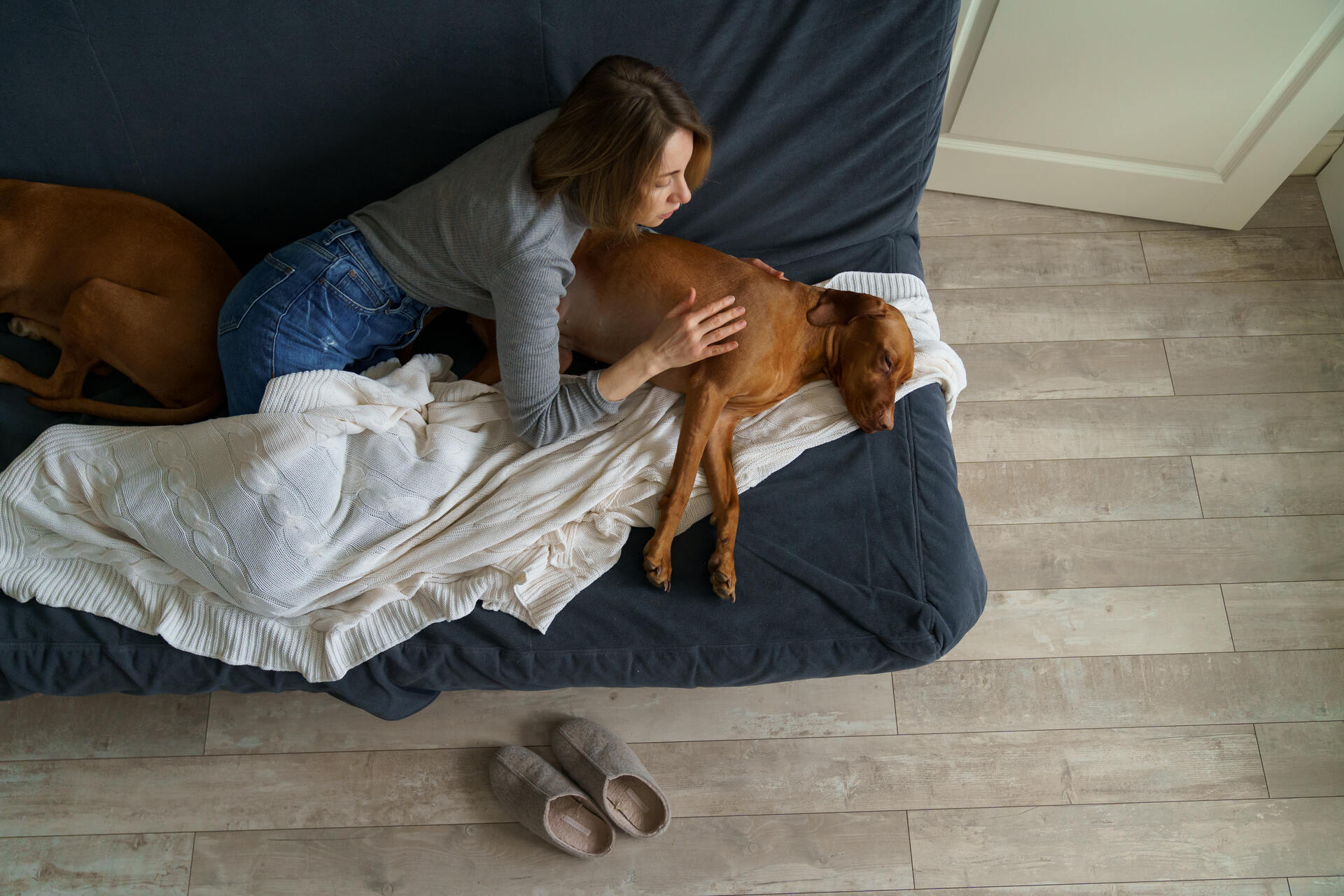
🐺 All of these behaviors might be due to your buddy trying to manage any pain or discomfort by themselves – trying to soldier through it like their grand-paws in the wild would have.
Which is where it’s good to know what behavioral changes to keep an eye out for – signs that something isn’t quite right and might need medical attention.
How to tell if your dog is in pain
Even the toughest pup will let slip that something isn’t right – from some change in their behavior. So if you’ve ever wondered, “How do I know if my dog is in pain?”, keep an eye out for signs like:
Panting without reason
Do dogs pant when in pain? Sadly, yes, panting – seemingly out of nowhere – tends to be one of the most common signs of pain in dogs.2
If you two have just come home from chasing a ball around the park, a bit of panting is no cause for concern. In fact, dogs usually pant to cool down from the heat outdoors – or if they’re excited.
But if the panting persists long after you’re both indoors and cooled down, watch out for other warning signs like:
- Any tension in your dog’s frame,
- Restlessness and pacing,
- And even other symptoms like drooling
⚠️ A whole bunch of medical conditions can cause your dog to breathe weirdly. Including pain, allergies, heat stroke, infection, something stuck in their throat, heart problems, or even lung-related health conditions.
So if you don’t see any obvious causes for your buddy panting more than usual, drop by your vet for a checkup.
Reduced activity
It’s normal for dogs to have days where they’d rather just snooze than be on the move. But in general, a drop in their activity that persists over time can be a concerning sign.3 Much like panting, this is another one of the first signs your dog may not be feeling well.
If you’re noticing your buddy:
- More reluctant around playtime,
- Seeming less interested in your usual walks together,
- Limping or seeming stiff after getting up,
- Or having difficulty getting up and down stairs or jumping up to reach a favorite high spot…
Then it could be a whole combination of factors causing your buddy’s reduced activity. Including growing older, dealing with physical discomfort, lethargy, and even painful conditions like arthritis, hip dysplasia, or injuries.

👩⚕️ It’s why vets recommend generally keeping track of your dog’s activity levels throughout the day. Since these conditions can worsen over time without proper treatment.

“Keep track of your dog’s energy levels, especially how long they are able to walk.
If you notice significant declines, it could be a sign of pain, heart disease, or other illness.”
– VCA Animal Hospitals4
Vocalization
Some dogs tend to be silent stoics – soldiering through the discomfort without a whine of protest. Others…not so much. If your once normally quiet dog seems to be howling, whining, whimpering, barking, or even growling more than usual – and without an apparent reason – they could be trying to tell you something feels off.5
Pay close attention to when your dog tends to vocalize more often than usual. Like, for example:
- When they’re on the move,
- While resting,
- After eating,
- Or while asleep.
All of which can help you and your vet identify what’s causing them any pain or discomfort.
Restlessness & difficulties sleeping
At this point, if you’re wondering, “My dog keeps moving around and can’t get comfortable,” – it could be another warning sign. Especially if your buddy seems more restless than usual, pacing around the house, unable to settle down or sleep properly. (And it’s not part of your nighttime ritual.)6
Now if your dog twitches around in their sleep every so often, it’s usually not a cause for concern. (In fact, it often means they’re just dreaming!)
But if your buddy is struggling to settle down, tossing and turning in their bed, frequently changing their sitting or sleeping positions, or unable to get comfortable, it could also be due to:
- Muscle soreness,
- Joint pain,
- Other internal issues,
- And even age-related cognitive problems that make it difficult for them to get a good night’s sleep.
All of which might make your buddy “walk out” the pain with restless pacing up and down.

Avoiding physical contact
If your cuddle-bug of a dog suddenly flinches or pulls away when you go to pet them, it could be another sign of pain.8
Dogs in pain may instinctively “protect” any sensitive areas of their body by turning away, crouching, or even hiding away from you. (Especially if they’re experiencing pain in specific regions, like their abdomen, back, or legs.)
Which might also turn up as…
Itching or pawing at a specific area
If your dog’s scratching themselves to bits, you wouldn’t be the first to think it might be due to an infection or allergy. After all, a flea infestation, lice in dogs, pollen in the air, or even food allergies can all trigger itching as a symptom.
But if your buddy’s injured or experiencing pain in some specific area, they might itch, scratch, paw or even bite at it to relieve some of their discomfort.9 (Which you might mistake for itching instead.)
Your dog might also lick and groom specific parts of their body excessively – maybe even losing some hair in the process in an effort to relieve any pain or discomfort.10
⚠️ Keep an eye out for any noticeable cuts, scrapes, or even debris lodged in your dog’s skin. Else, if it’s pain in their bones, muscles, or inner organs, your buddy might turn or crouch away from you to prevent you from touching that area.
Changes in eating, drinking & toilet habits
Pain can also send your dog’s appetite out the window. If they start eating less or just ignore their food bowls altogether – it could be a sign of discomfort.11 (Especially if they usually snarf down their kibble within seconds.)
Likewise, keep an eye out for your buddy’s drinking habits. It’s both a concerning sign if your dog suddenly:
- Seems to lose all interest in drinking water,
- Just as it is if you find them suddenly drinking too much water
All of these signs could point to reasons as diverse as dental pain, gastrointestinal issues, diabetes, heat stroke – or something more serious.

🪠 Likewise, toilet trouble can be another sign of pain in dogs.12 If your buddy uses a different posture to do their business, it could signal pain in their stomach, back, or limbs.
But now that you know what changes in behavior might count as the signs of pain in dogs, you’re that much better informed when to head to your vet.
Steps your vet might take once you’ve dropped by
Your vet will start by doing a full physical examination of your dog – including their joints, muscles, and spine – trying to figure out what’s causing them any pain or discomfort. This can help them pick up any signs of injury, swelling, weird movements, stiffness, or tenderness that might signal sickness or chronic health condition.
Depending on your dog’s symptoms, your vet might recommend other diagnostic tests. Which might include an X-ray, blood work, or even an ultrasound in more serious cases. These tests can help identify conditions like arthritis, injuries, or infection that might not be visible with just a physical exam.
Once they’ve narrowed down what might be causing your buddy their symptoms, your vet might prescribe your dog:
- Specific pain-relieving medications that can help provide your buddy some relief. These might include non-steroidal anti-inflammatory drugs (NSAIDs), muscle relaxers, or corticosteroids, depending on the cause.
- Physical therapy, especially if joint or muscle pain turns out to be the cause. Hydrotherapy can also be a joint-friendly option to help strengthen your buddy’s muscles, reduce inflammation, and help them get mobile again.
- A change in diet, including specific supplements that can help support dogs’ joint health.
- Surgery, in more serious cases, especially if your buddy’s dealing with injury or severe joint problems.
How you can create a supportive environment at home
As your buddy recovers – and gets better – you do want to avoid a relapse of their symptoms. So here are some steps you can take to make home as comfortable a place as possible.
- Use pet ramps to help your dog get on the couch or bed. You could use baby gates to block off any stairs as well.
- Keep any essentials, like food and water bowls or toys, at ground level. Else, consider investing in elevated food or water bowls to prevent your buddy from having to bend over and strain their neck muscles and joints too much.
- Use non-slip rugs or mats to reduce any risk of falls. Carpet runners can also help make it easier for your dog to get around without slipping.

- Create multiple “nap” spots, with mats or rugs to help your buddy get some rest around the house.
- An orthopedic or memory foam dog bed can help reduce pressure on your dog’s joints and make it easier for them to sleep comfortably.
- Heat therapy, in the form of a warm heating pad or a heated blanket on your dog’s bed, can be incredibly soothing if your buddy has any joint or muscle pain. Just make sure to supervise your dog while handling any heat source to avoid burns.
In all cases, make sure you follow your vet’s instructions to a T – especially if they’ve recommended any changes in diet, activity, or medication.
💡 And most importantly…
- Monitor any changes in your dog’s behavior. Including their eating, drinking, and toilet habits – but also their activity levels and sleep quality.
Which you could do by jotting these down in a journal to share with your vet.
Or you could use the the actionable data you get from an Activity Tracker built for pets.
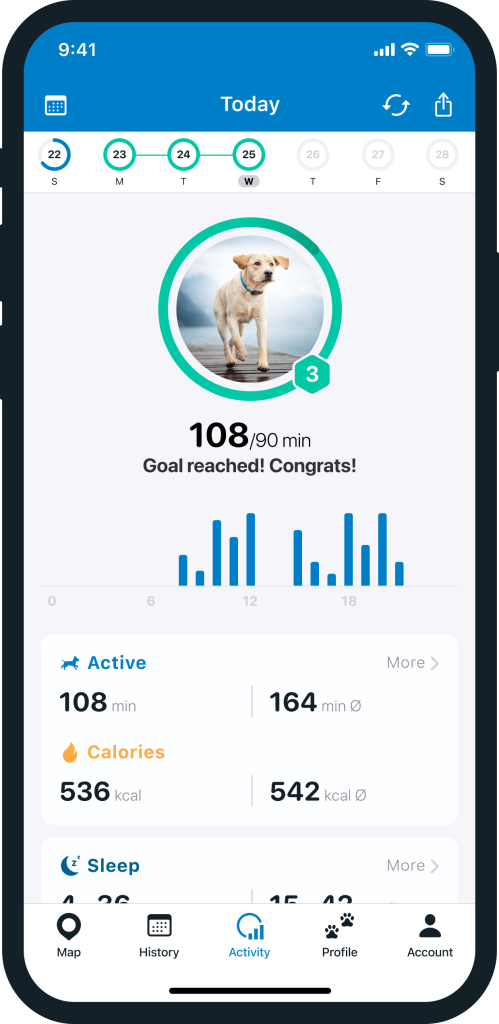
With its built-in motion detector, your trusty Tractive GPS doubles as an Activity Tracker for dogs. Monitoring your buddy’s movements throughout the day and logging them in as “active minutes.”
Which, with time, can help you figure out:
- How active your dog is on the regular – i.e., when they’re healthy
- If there’s a weird drop in your dog’s active minutes. Which could signal sickness, injury, or pain
- If there’s a weird spike in your dog’s active minutes. Which could signal the restless pacing your dog might get up to shake off the pain or discomfort
And even if you miss a day of checking your dog’s active minutes – we’ve got you covered.
🚨Your tracker sends you a Health Alert just as it notices your buddy’s activity level dropping below a certain level. So you can take action and get them to a vet right away.
Saving yourself a ton of time, money, energy – and potentially your dog’s life, while at it.
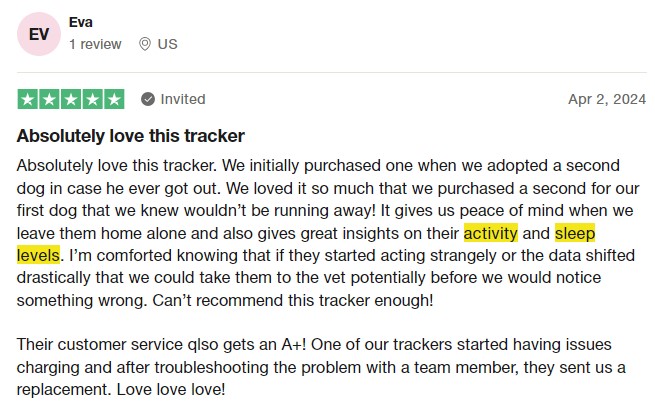
Ready to help your buddy live a happy, pain-free life?
Your dog’s behavior speaks louder than any amount of howling, whining, or demands for attention. And more often than not, a change in their regular behavior might be among the signs of pain in dogs.
Which can include symptoms like:
- Increased panting, often without any reason.
- Reduced activity, whether it’s seeming more reluctant around walks or playtime or having difficulties getting around.
- Vocalizing, including howling, whining, whimpering, barking, or even growling.
- Difficulties sleeping, including tossing and turning, unable to get comfortable, or even restless pacing.
- Avoiding physical contact, like if they’re “shielding” a sensitive part of their body where they’re experiencing pain
- Itching or pawing at a specific area where they might be experiencing pain
- Not eating or drinking as much as usual.
By keeping a close eye on these signs, you’re better-equipped to catch on to them early and get your buddy the help they need.
💡 And if you’d like to have a more productive conversation with your vet…
An Activity Tracker for dogs means you can now share actionable data based on your buddy’s normal patterns.
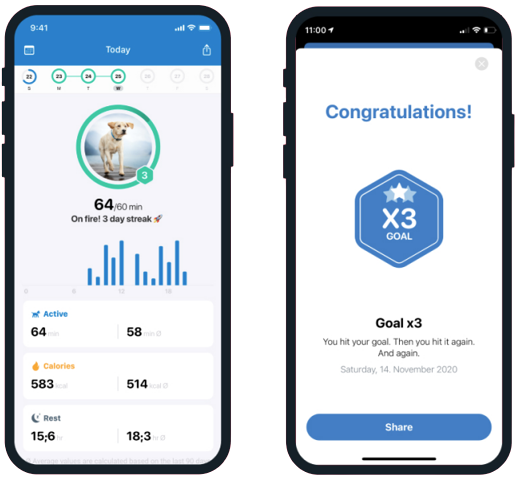
Because why rely on your memory and risk missing some important details – which could affect your dog’s health and well-being down the line?
🐶 Rather, with some vigilance, a few home adjustments, and the support of your vet, you can help your dog live a long, happy, comfortable life – even if they’re dealing with pain.
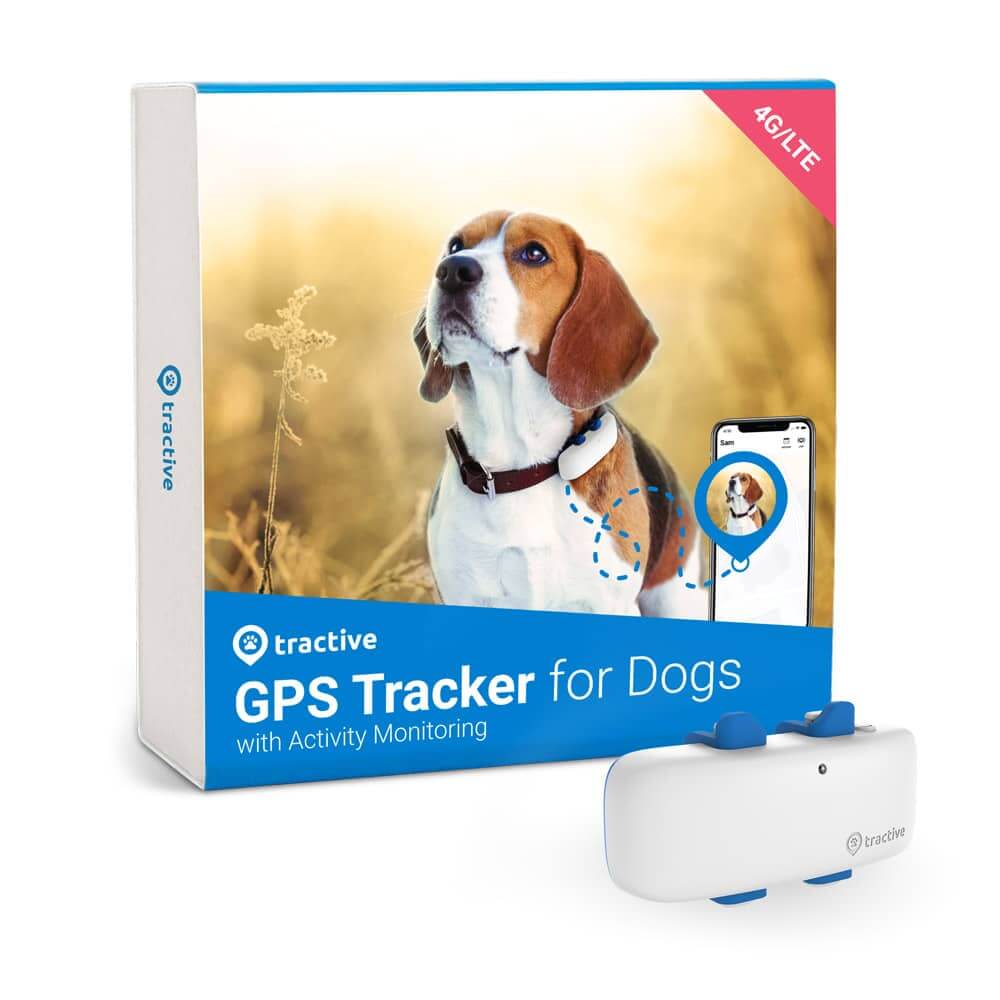
Stay on top of your dog’s wellness
Follow every step in real-time with unlimited range. Get alerts if they wander too far. Keep them happy & healthy with Wellness Monitoring. And let others – like walkers or sitters – keep an eye on your dog too.
Here’s Dr. Adam (and his dog, Bo) from K9 Active Health walking you through some of the less obvious signs of pain in dogs:
And if you’ve liked this post, share it with a friend or a loved one – and let’s help build a safer, kinder world for our furry friends together.
Your furry friend’s health and wellbeing means as much as to us as it does to you. So we’ve made it a priority to only share medically-relevant content on our blog.
This post was checked, double-checked, and medically verified by Georgia-based vet, Dr. Dwight Alleyne.

Originally from Long Island, New York, Dr. Alleyne began his career at a no-kill animal shelter before becoming a licensed veterinary technician. He graduated from Cornell University Veterinary College in 2006 and completed an internship at Purdue University.
Now practicing in Georgia, Dr. Alleyne specializes in soft tissue surgery and ultrasounds. He also writes pet health articles on his website, “The Animal Doctor Blog” (www.anmldrblog.com).




